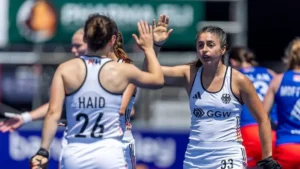Four-time Olympian and javelin thrower Kara Winger has seen a change happening. Not only are more women coming to sport, but they are also being celebrated and promoted as equals to their male counterparts, they’re getting more coverage on TV and in print, and they are getting more financial recognition. There is still a long way to go to ensure sport is as accessible for girls as it is for boys, but progress is being made.
Here, Winger talks about what being a role model in sport means, how the narrative around girls in sport is changing, and why professional women athletes are a necessary part of that change.
Visibility
We know that sports are about so much more than scoring goals and winning competitions, and when girls aren’t able to see a pathway to sport, they miss more than just physical activity. “I grew up playing sports, but mostly in order to make friends,” Winger recalls. “We moved 10 times before I was in fifth grade, and I was really shy. I found it easier to play sports than to talk to other kids. It was my way to instantly be part of a community and make friends. I wasn’t necessarily a great athlete, but I enjoyed trying hard and having people around me.”
Winger was lucky that she had that early intuition to get involved in sports, but it wasn’t until recent years that women athletes became more visible in sports media, and the numbers for girls’ sport participation finally began to rise (though there’s still a lot of work to be done). And now, with athletes like Caitlyn Clark, Simone Biles, and Katie Ledecky constantly in the headlines, it feels as though there is finally a cultural shift towards normalizing and celebrating girls and women in sport.
Opportunity
As coaches and caregivers to young athletes, you have a huge opportunity right now. Young girls and boys are watching and learning from what they see athletes and coaches saying and doing. They’re seeing how the media portrays athletes, and if we can continue on the path of broadening awareness and interest in women’s sport, we start to set the precedent that girls and women are just as capable and valid athletes as men. At the same time, young men can find their role in lifting the voices and experiences of women athletes.
This doesn’t mean that coaches and caregivers (or the female athletes themselves) should feel a greater pressure to perform or to ‘turn pro.’ Ultimately, what will bring more girls and women to sport is a sense that regardless of their level, they belong on the field. As Winger noted, she wasn’t an amazing athlete as a child. She played plenty of sports—soccer, softball, basketball, volleyball, swimming, track—and didn’t excel at all of them. It wasn’t until high school that she found the javelin, thanks to the recommendation of her track coach.
“We just hung out every day and got to be outside,” she recalls. “I loved my teammates, and I really enjoyed the puzzle of learning how to throw. I accelerated pretty quickly, but it was the newness of it that I really loved and the individual pursuit while still being part of a team.”
Inspiration
It may come as a shock, but 2024 marks the first time in history that the Olympics will have full gender equality. And that’s a major opportunity for women’s sport. “Right now, women and girls in sport are thriving,” says Winger. “It’s been building for so many years and it really has such momentum now. I see women like Sha’Carri Richardson competing on the track now and watching her become the best version of herself in such a loud way is really, really fun. And the way that she uplifts women around her is very exciting.”
Winger also adds that visibility is increasing across a range of sports, and with that, a range of body types. That’s an important message for young girls to see, since not every girl fits the cliche “athlete” stereotype. Para athletes are also becoming more visible as media coverage becomes more inclusive of the Paralympic Games.
“Even visibility of the different events is such an exciting thing for me,” says Winger. “I still get a little bit frustrated with the narrowness of sports. It’s only around the Olympics that there’s attention around such a wide variety of sports, but in every other year, we should be showcasing the many ways that women and girls can participate in sport. Sports like speed climbing and field events like javelin that only get attention during the Games are all great options for girls but are so often overlooked.”
As women’s sport is on the rise, it’s easy to forget about the role that men can play in becoming fans and champions of women’s sport, but Winger is also quick to point out that men uplifting women’s stories is a powerful way to bring women’s sport to more people.
Takeaway
With women’s sports growing fast in terms of media coverage and financial support, the face of youth sport will likely see a change as well. Olympian Kara Winger explains why visibility in elite sport will serve to bring more young girls into sport, and how coaches and caregivers can support the growth of women and girls in sport.
About TrueSport
TrueSport®, a movement powered by the experience and values of the U.S. Anti-Doping Agency, champions the positive values and life lessons learned through youth sport. Backed by U.S. Congressional mandate, TrueSport inspires athletes, coaches, parents, and administrators to change the culture of youth sport through active engagement and thoughtful curriculum based on cornerstone lessons of sportsmanship, character-building, and clean and healthy performance, while also creating leaders across communities through sport.
For more expert-driven articles and materials, visit TrueSport’s comprehensive collection of resources.
This content was reproduced in partnership with TrueSport. Any content copied or reproduced without TrueSport and the U.S. Anti-Doping Agency’s express written permission would be in violation of our copyright, and subject to legal recourse. To learn more or request permission to reproduce content, click here.
By USWNT







